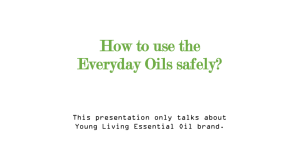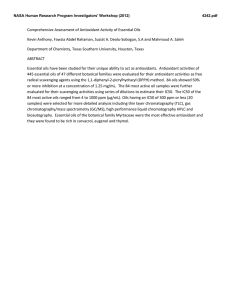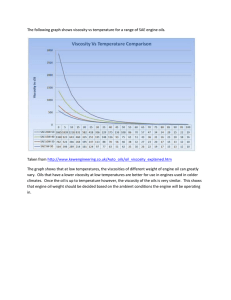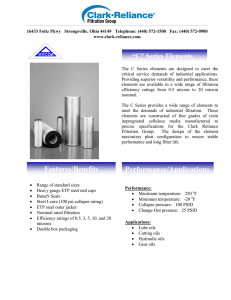pure™ essential oils — frequently asked questions
advertisement
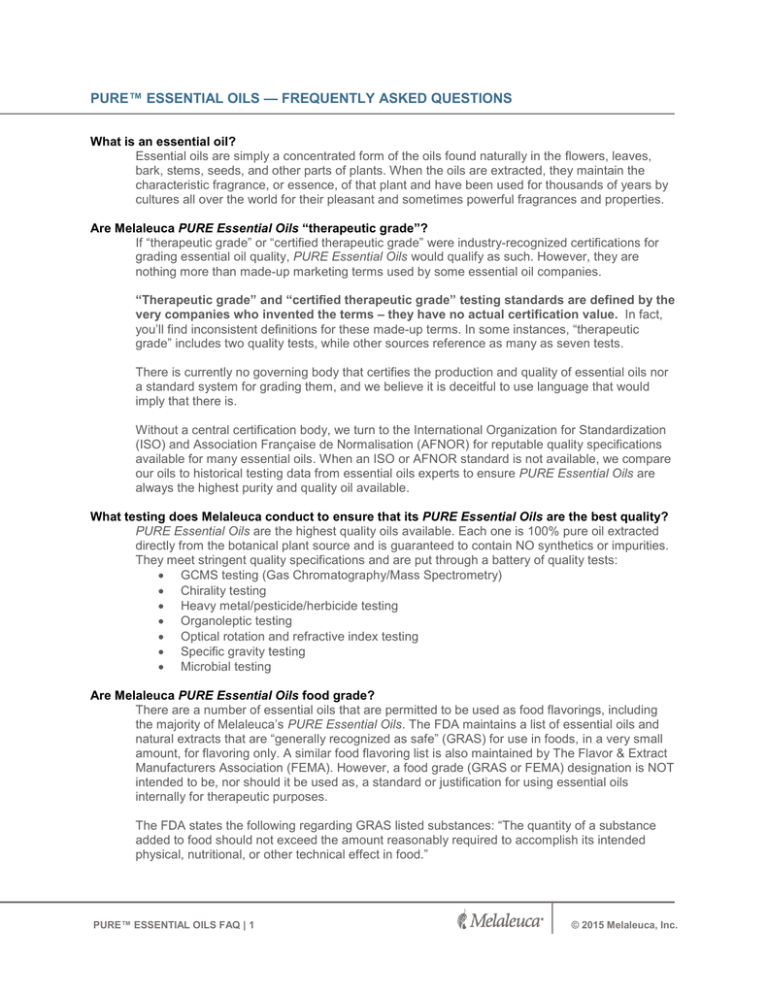
PURE™ ESSENTIAL OILS — FREQUENTLY ASKED QUESTIONS What is an essential oil? Essential oils are simply a concentrated form of the oils found naturally in the flowers, leaves, bark, stems, seeds, and other parts of plants. When the oils are extracted, they maintain the characteristic fragrance, or essence, of that plant and have been used for thousands of years by cultures all over the world for their pleasant and sometimes powerful fragrances and properties. Are Melaleuca PURE Essential Oils “therapeutic grade”? If “therapeutic grade” or “certified therapeutic grade” were industry-recognized certifications for grading essential oil quality, PURE Essential Oils would qualify as such. However, they are nothing more than made-up marketing terms used by some essential oil companies. “Therapeutic grade” and “certified therapeutic grade” testing standards are defined by the very companies who invented the terms – they have no actual certification value. In fact, you’ll find inconsistent definitions for these made-up terms. In some instances, “therapeutic grade” includes two quality tests, while other sources reference as many as seven tests. There is currently no governing body that certifies the production and quality of essential oils nor a standard system for grading them, and we believe it is deceitful to use language that would imply that there is. Without a central certification body, we turn to the International Organization for Standardization (ISO) and Association Française de Normalisation (AFNOR) for reputable quality specifications available for many essential oils. When an ISO or AFNOR standard is not available, we compare our oils to historical testing data from essential oils experts to ensure PURE Essential Oils are always the highest purity and quality oil available. What testing does Melaleuca conduct to ensure that its PURE Essential Oils are the best quality? PURE Essential Oils are the highest quality oils available. Each one is 100% pure oil extracted directly from the botanical plant source and is guaranteed to contain NO synthetics or impurities. They meet stringent quality specifications and are put through a battery of quality tests: GCMS testing (Gas Chromatography/Mass Spectrometry) Chirality testing Heavy metal/pesticide/herbicide testing Organoleptic testing Optical rotation and refractive index testing Specific gravity testing Microbial testing Are Melaleuca PURE Essential Oils food grade? There are a number of essential oils that are permitted to be used as food flavorings, including the majority of Melaleuca’s PURE Essential Oils. The FDA maintains a list of essential oils and natural extracts that are “generally recognized as safe” (GRAS) for use in foods, in a very small amount, for flavoring only. A similar food flavoring list is also maintained by The Flavor & Extract Manufacturers Association (FEMA). However, a food grade (GRAS or FEMA) designation is NOT intended to be, nor should it be used as, a standard or justification for using essential oils internally for therapeutic purposes. The FDA states the following regarding GRAS listed substances: “The quantity of a substance added to food should not exceed the amount reasonably required to accomplish its intended physical, nutritional, or other technical effect in food.” PURE™ ESSENTIAL OILS FAQ | 1 © 2015 Melaleuca, Inc. If you have been using some of these essential oils, designated as GRAS, for food flavoring, you may continue to use them for this purpose. Please remember, equating the safety of straight essential oil ingestion to its safe use as a flavoring agent is reckless. Should essential oils be ingested? The internal use of essential oils should only be administered under the supervision of a healthcare practitioner. This recommendation is in no way a reflection on the quality of Melaleuca’s PURE Essential Oils. Instead, it follows the guidance of professional aromatherapy organizations and independent industry experts who specialize in essential oil safety. There are very few companies that make the dangerous claim that straight essential oils should be ingested. The practice of casually recommending oil ingestion is careless and irresponsible. Essential oils contain a variety of highly concentrated, powerful constituents that, when used improperly, can lead to injury and long-term negative health effects. Does Melaleuca grow its own plants to make PURE Essential Oils? Just like we have done for the last 30 years, we carefully choose our partners based on a strict set of guidelines to guarantee that you are getting the best quality oil available and that the farmers are using sustainable and ethical farming practices. How are PURE Essential Oils extracted? The method of extraction varies from oil to oil, depending on the part of the plant that was used to obtain the oil. The majority of PURE Essential Oils are steam distilled, citrus oils are cold pressed, and jasmine absolute is obtained through a delicate extraction process. You can see the specific method of extraction for a particular oil by visiting that oil’s product detail page at Melaleuca.com/EssentialOils. Are PURE Essential Oils organic? Melaleuca partners with farmers who use sustainable and ethical farming practices to grow the plants needed to obtain PURE Essential Oils. Each oil is guaranteed to be free of pesticides, herbicides, and heavy metals. Organic certifications are granted by government agencies. Many of Melaleuca’s PURE Essential Oils are extracted from plants grown in countries where organic certifications are not available. Can PURE Essential Oils be used in a diffuser? Absolutely. Using PURE Essential Oils in a diffuser is an excellent way to fill your home with the aromatic notes of some of nature’s most fragrant botanicals. The Melaleuca PURE Ultrasonic Diffuser + Humidifier uses high-frequency vibrations to create an ultra-fine mist—without the use of heat or chemicals—to maintain the integrity of PURE Essential Oils. How do I know if a particular essential oil should be used with a carrier oil? Each oil has a unique set of recommended uses to help you get the most out of your PURE Essential Oils. For information on how to use a particular oil, start by reading the product label, which will give you some basic usage directions. If you’re looking for more information, visit Melaleuca.com/EssentialOils and click on your specific oil. For dilution suggestions, refer to the label or product detail page of PURE Fractionated Coconut Oil or PURE Sweet Almond Carrier Oil for dilution instructions. How do I know where to apply an essential oil on my body? Based on the composition of an oil, there may be areas of the body where it can be applied and others that should be avoided. Oils that may cause irritation to areas with sensitive skin are marked by the “sensitive” icon on the product detail page at Melaleuca.com. As a general rule, PURE™ ESSENTIAL OILS FAQ | 2 © 2015 Melaleuca, Inc. essential oils should never be applied to the eyes, inner ear, or to mucous membranes. For a full list of how and where to use an oil, visit Melaleuca.com/EssentialOils and click on your specific oil. Can essential oils be used on children? Extra care should be taken with using essential oils on children. Please pay special attention to the dilution guidelines on the PURE Carrier Oils: Children or sensitive skin = 1 drop essential oil + 1 tsp. carrier oil General, daily use = 2 drops essential oil + 1 tsp. carrier oil Periodic use = 3 drops essential oil + 1 tsp. carrier oil Also, please refer to the “Use” and “Commonsense Caution” on each product label. If it is your first time using a particular oil on young or sensitive skin, dilute properly and apply to only a small patch of skin to ensure no reaction occurs before the oil is applied more broadly. Can essential oils be used while pregnant or nursing? While many essential oils appear to be safe for use while pregnant or breastfeeding, you should consult your health-care practitioner before introducing any new element into your pre- or postnatal care, including the use of essential oils. Additionally, certain oils should be avoided while pregnant or breastfeeding, including, but not limited to, wormwood, rue, oakmoss, Lavandula stoechas, camphor, parsley seed, sage, and hyssop. How do I know if an essential oil will or has the potential to irritate my skin? Each person can respond differently to an essential oil. Please refer to the “Use” and “Commonsense Caution” on each product label. If it is your first time using a particular oil on young or sensitive skin, dilute properly and apply to only a small patch of skin to ensure no reaction occurs before the oil is applied more broadly. What should I do if I experience skin discomfort or irritation after using an essential oil? You should discontinue use of that particular oil if irritation occurs. You can dilute and calm essential oils that have already been applied to the skin by adding a few drops of a PURE Carrier Oil to the affected area. I’ve heard I should avoid sunlight after using some essential oils. Is this true? Yes, some oils, especially citrus oils, can increase your skin’s sensitivity to sunlight and magnify the effect of harmful ultra-violet rays. Oils that may increase your sensitivity to sunlight are marked with the "Photosensitive" icon on the oil’s product detail page at Melaleuca.com and note the increased chance for photosensitivity in the “Commonsense Caution” section on the product label. Be careful to avoid sunlight for 12 hours after applying the oil to your skin or until the oil has completely washed off. Do essential oils interact with prescription medication? Generally, essential oils do not interact with prescription medications when applied topically or used aromatically. However, it is prudent to consult with your health-care practitioner before using essential oils while taking prescription medication, or if you have a blood clotting disorder. PURE™ ESSENTIAL OILS FAQ | 3 © 2015 Melaleuca, Inc.
